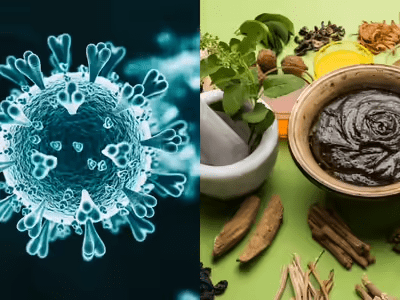Abstract
Long Covid, also known as post-COVID-19 condition, represents a multifaceted health challenge emerging from the SARS-CoV-2 pandemic, affecting millions worldwide even as we approach the latter half of 2025. This research article provides an in-depth exploration of Long Covid, defining it as a chronic syndrome where symptoms persist or emerge weeks to months after the initial infection, often lasting for extended periods. Drawing from recent epidemiological data, we detail over 200 reported symptoms, ranging from fatigue and brain fog to organ-specific impairments, and examine its pathophysiology, including persistent inflammation, viral remnants, and immune dysregulation. The duration of Long Covid varies, with many experiencing relief within 4-9 months, though some endure symptoms for years. While conventional treatments focus on symptom management and rehabilitation, this article emphasizes Ayurvedic methods as complementary approaches to address long-term inflammation. Rooted in ancient Indian medicine, Ayurveda offers holistic strategies such as herbal Rasayanas, Panchakarma detoxification, dietary regimens, and Yoga to restore balance, reduce inflammation, and enhance immunity. Supported by emerging scientific studies, including trials like APRIL on Ashwagandha, we discuss how these methods can mitigate post-viral effects. This comprehensive review synthesizes global health insights from organizations like WHO and CDC, alongside Ayurvedic perspectives, to advocate for integrated care in managing Long Covid’s lingering impacts.
Introduction
The COVID-19 pandemic, caused by the SARS-CoV-2 virus, has left an indelible mark on global health since its emergence in late 2019. As of August 23, 2025, over five years into the post-pandemic era, one of the most persistent legacies is Long Covid—a condition that extends beyond the acute phase of infection, manifesting as a spectrum of debilitating symptoms that can profoundly affect quality of life. It is estimated that 50-70% of COVID-19 survivors may experience some form of Long Covid, with prevalence rates suggesting it is more common than previously thought, particularly in populations with repeated exposures or severe initial infections.
This article aims to provide a comprehensive research overview of Long Covid, beginning with its definition and epidemiological context. We will delve into its myriad symptoms, underlying causes, and typical duration, drawing on the latest 2025 research from institutions like the American Medical Association (AMA), Centers for Disease Control and Prevention (CDC), World Health Organization (WHO), and academic journals. Subsequently, we shift focus to Ayurvedic methods, an ancient system of medicine from India, which offers promising tools for addressing the long-term inflammation central to Long Covid’s pathology. By integrating traditional wisdom with modern scientific studies, this piece underscores the potential of holistic approaches in a landscape where conventional medicine often falls short on curative options.
The keyword “Long Covid” encapsulates this enduring health issue, highlighting the need for multidisciplinary strategies. As we explore, Long Covid’s impact spans physical, mental, and social domains, necessitating informed, evidence-based interventions to support recovery.
Definition and Epidemiology of Long Covid
Long Covid, formally termed post-COVID-19 condition (PCC) by the WHO, is defined as a range of symptoms that typically begin within three months of the initial COVID-19 infection and persist for at least two months, without an alternative explanation. The National Academies of Sciences, Engineering, and Medicine (NASEM) specifies a minimum duration of three months, emphasizing its chronic, systemic nature with profound consequences on daily functioning. This definition aligns with broader characterizations, such as those from the CDC, which describe Long Covid as signs, symptoms, and conditions that continue or develop after initial SARS-CoV-2 infection, lasting weeks, months, or years.
Epidemiologically, Long Covid affects a significant portion of the population. A 2025 study from Oregon Health & Science University suggests it is more prevalent than earlier estimates, with global data indicating that approximately 15% of individuals still experience symptoms at 12 months post-infection. Risk factors include female sex, older age, smoking, obesity, pre-existing chronic conditions, and severe acute COVID-19 requiring hospitalization. Higher incidences are observed in populations with disabilities, health disparities, and limited healthcare access. A meta-analysis of controlled studies, encompassing over 14 million participants, found elevated relative risks for symptoms like loss of smell (RR 4.31) and taste (RR 3.71), with variations based on hospitalization status and demographics, such as higher risks in cohorts with more male participants for certain symptoms.
In 2025, research highlights Long Covid’s uniqueness compared to other respiratory illnesses like flu or pneumonia, with persistent symptoms like fatigue (25.4%), shortness of breath (24.7%), and joint pain (24.1%) not commonly seen in those comparators. The condition’s heterogeneity—over 200 symptoms affecting multiple systems—underscores its complexity, with clusters varying by individual. Globally, repeated infections exacerbate risks, emphasizing vaccination and preventive measures as key to mitigation.
Symptoms of Long Covid
The symptoms of Long Covid are diverse and can impact nearly every organ system, with more than 200 documented manifestations. They often emerge, persist, resolve, and reemerge unpredictably, ranging from mild to severely debilitating. Common categories include:
General Symptoms
– Fatigue or tiredness interfering with daily life, often worsening after physical or mental exertion (post-exertional malaise).
– Fever, aches, and pains in muscles or joints.
– Internal tremors, a less-discussed but common symptom noted in recent AMA research.
Respiratory and Cardiovascular Symptoms
– Shortness of breath or difficulty breathing.
– Cough, chest pain or tightness.
– Fast-beating heart (palpitations) or resting tachycardia.
– Symptoms akin to postural orthostatic tachycardia syndrome (POTS).
Neurological Symptoms
– Brain fog (difficulty thinking or concentrating).
– Headaches, sleep problems (insomnia), dizziness, pins-and-needles sensations.
– Loss or change in smell (anosmia) or taste (ageusia).
– Depression, anxiety, impaired memory, confusion.
Digestive and Other Symptoms
– Diarrhea, stomach pain, constipation.
– Joint or muscle pain, rash, changes in menstrual cycles.
– Hair loss (alopecia), tinnitus, earaches.
Symptoms vary widely; for instance, hospitalized patients show higher risks for sensory losses like smell (RR 11.05) and taste (RR 8.59), while non-hospitalized individuals report more cognitive issues like poor concentration (RR 4.86). In Ayurvedic terms, these align with doshic imbalances, such as Vata aggravation causing neurological deficits or Kapha leading to respiratory issues. Variability stems from individual factors, with some experiencing multi-organ effects or autoimmune flares. Seeking care is advised for persistent, unexplained symptoms.
Causes and Pathophysiology of Long Covid
The causes of Long Covid remain under investigation but are multifactorial. Key mechanisms include:
– **Viral Persistence**: Remnants of SARS-CoV-2 may linger in tissues, triggering ongoing immune responses.
– **Immune Dysregulation**: Overactive immunity leads to autoimmunity or chronic inflammation, with elevated angiotensin II promoting vasoconstriction and thrombosis.
– **Organ Damage**: Direct viral invasion via ACE2 receptors affects lungs (edema, fibrosis), heart (myocarditis), brain (crossing blood-brain barrier), and other systems.
– **Micro-Thrombosis and Endothelial Dysfunction**: Formation of clots disrupts blood flow.
From an Ayurvedic viewpoint, Long Covid correlates with agnimandya (weak digestion), ama (toxin accumulation), dhatu-kshaya (tissue depletion), and ojakshaya (vitality loss), stemming from viral “visha” (poison) aggravating doshas. This holistic lens views symptoms as imbalances in Pranavaha Srotasa (respiratory channels) or other systems, influenced by individual constitution.
Recent 2025 research links Long Covid to increased risks of new diseases like diabetes and cardiovascular issues, with inflammation as a core driver.
Duration and Prognosis of Long Covid
Long Covid’s duration is variable, with symptoms lasting weeks, months, or years. Most improve within 4-9 months, but about 15% persist at 12 months. Studies show follow-ups from 28 to 685 days, with higher persistence in hospitalized cases. Prognosis depends on severity, comorbidities, and interventions; many recover fully, but some develop chronic conditions like ME/CFS.
The Role of COVID-19 Vaccination in Long Covid
As of 2025, extensive research underscores the protective role of COVID-19 vaccination against Long Covid, both in preventing its onset and potentially mitigating symptoms in those already affected. Vaccination primarily works by reducing the severity of the initial infection, thereby lowering the likelihood of persistent post-viral effects. Pre-infection vaccination is associated with a decreased risk of developing various post-COVID conditions, offering a layer of protection against the long-term effects of the virus.
Prevention of Long Covid
Multiple studies confirm that vaccination significantly lowers the incidence of Long Covid. A literature review by the European Centre for Disease Prevention and Control (ECDC), incorporating seven high-quality studies from Europe and similar regions, found that full vaccination before infection reduced the risk of developing Long Covid by approximately 27% in adults. Six of these studies reported statistically significant reductions, highlighting vaccination’s role in preventing post-COVID-19 condition (PCC) as defined by the WHO. This protective effect is attributed to vaccination’s ability to mitigate severe acute disease and mortality, which in turn decreases the likelihood of lingering symptoms.
In children and adolescents, evidence is emerging that vaccination is equally beneficial. Unvaccinated youth are up to 20 times more likely to develop Long Covid compared to their vaccinated peers, according to recent analyses. Vaccination also appears effective in immunocompromised patients, reducing Long Covid risk in both immunocompetent and immunocompromised populations. Furthermore, studies in low- and middle-income countries using deep learning models indicate that vaccination offers promising benefits in mitigating prolonged symptoms, even in resource-limited settings.
The cumulative nature of Long Covid risk with repeated infections emphasizes the importance of up-to-date vaccinations, including boosters tailored to circulating variants. The CDC recommends the updated 2024-2025 COVID-19 vaccines for all individuals aged 6 months and older to maintain this protection.
Mitigation and Treatment Effects
For individuals already experiencing Long Covid, vaccination may offer symptomatic relief, though results vary. A prospective observational study from Yale University (NCT04895189) involving 16 vaccine-naïve participants with Long Covid examined post-vaccination outcomes. At 12 weeks post-vaccination, 10 participants reported improved health status, with reductions in symptom burden—median physical effect scores dropped from 63 to 36, and social effect scores from 35 to 17. Vaccination was associated with increased SARS-CoV-2 spike protein-specific IgG and T-cell expansion, suggesting enhanced immune responses contribute to symptom alleviation.
However, outcomes were not uniform: three participants reported no change, and three experienced worsening symptoms. Immune biomarkers provided insights—higher baseline soluble IL-6 receptor (sIL-6R) levels correlated with improvement, while elevated interferon-beta (IFN-β) and ciliary neurotrophic factor (CNTF) were linked to non-improvement or deterioration. This variability underscores the need for personalized approaches and larger, controlled studies to predict responses.
Limitations in current evidence include small sample sizes, lack of controls in some studies, and limited data on vaccination’s impact on symptom duration, particularly in children, adolescents, and immunocompromised groups. Risks associated with vaccination, such as rare cases of myocarditis or pericarditis (noted with vaccines like Novavax), should be weighed, but overall benefits in preventing severe outcomes and Long Covid outweigh these for most populations.
In summary, COVID-19 vaccination plays a crucial role in reducing Long Covid incidence and severity, reinforcing its importance in public health strategies alongside other preventive measures like masking and antivirals.
Conventional Management of Long Covid
Management is individualized, focusing on symptomatic relief, rehabilitation, and treating new conditions. Strategies include medications, energy conservation, assistive devices, and multidisciplinary care. WHO guidelines emphasize self-management for flares. Vaccination reduces risk.
Ayurvedic Perspectives on Long Covid
In Ayurveda, Long Covid is viewed as a post-viral syndrome akin to Jeerna Jwara or Kshatakshina, involving dosha derangements, ama buildup, and ojas depletion. Symptoms like fatigue reflect Vata-Kapha imbalance, while inflammation ties to Pitta aggravation. The approach holistically addresses root causes through diet, herbs, and lifestyle.
Ayurvedic Methods for Managing Long-Term Inflammation in Long Covid
Ayurveda excels in anti-inflammatory strategies, targeting long-term inflammation via:
1. Herbal Rasayanas and Formulations
– **Ashwagandha (Withania somnifera)**: Anti-inflammatory and immunomodulatory; APRIL trial tests it for functional improvement, fatigue, and quality of life in Long Covid. Dosage: 500-1000mg daily, under guidance.
– **Guduchi (Tinospora cordifolia)**: Boosts immunity, reduces inflammation; used in Samshamani Vati.
– **Turmeric (Curcuma longa)**: Haridra churna for anti-viral and anti-inflammatory effects.
– Others: Amalaki, Vasa, Draksha for tissue nourishment; Chyawanprash for overall rejuvenation.

2. Panchakarma Detoxification
– Deepana-Pachana: Spices to ignite digestion and remove ama.
– Procedures: Abhyanga, Swedana, Virechana, Basti, Nasya to eliminate toxins, reduce micro-clotting, and inflammation.
3. Dietary and Lifestyle Regimens (Pathya Vyavastha)
– Avoid processed foods; favor anti-inflammatory diets with ginger, tulsi, triphala.
– Dinacharya: Daily routines for balance.
4. Yoga and Pranayama
– Asanas, Pranayama, Kapalabhati to enhance respiratory function, reduce stress.
These methods, when personalized, can realign immune responses and alleviate inflammation.
Scientific Studies on Ayurveda for Long Covid
Emerging research supports Ayurveda’s efficacy. A PMC study shows Ayurveda as add-on reduces lingering symptoms in mild-moderate cases. Another reports dietary focus resolving severe symptoms. The APRIL trial, recruiting 2,500 participants, evaluates Ashwagandha’s impact on functional status. Long-term surveillance shows fewer post-COVID incidences with add-on Ayurveda. Neurological management via Ayurveda addresses inflammation-driven symptoms. These studies, though preliminary, indicate benefits in immunity, recovery, and quality of life.
Conclusion
Long Covid remains a significant health burden in 2025, with its symptoms, causes, and variable duration demanding comprehensive care. The inclusion of COVID-19 vaccination as a preventive and mitigative tool enhances conventional strategies, while Ayurvedic methods offer valuable complementary approaches for managing long-term inflammation, integrating herbs, detoxification, diet, and Yoga to foster recovery. As research evolves, blending these with vaccination and modern medicine could optimize outcomes, promoting holistic well-being for those affected.





0 Comments